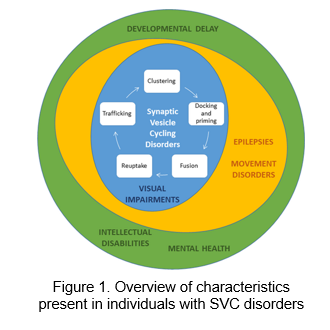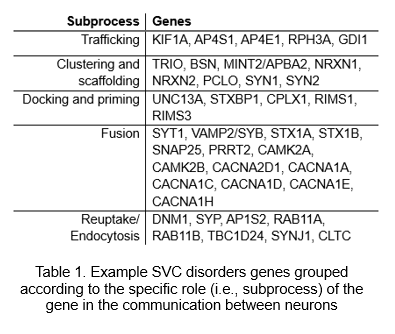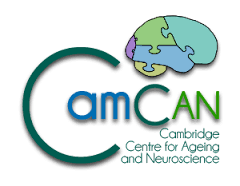The neurodevelopmental spectrum of synaptic vesicle cycling disorders.
John, A., Ng-Cordell, E., Hanna, N., Brkik, D., & Baker, K. (2020).
Journal of Neurochemistry, 157, 208-228.
What did we do?
- Different genetic disorders caused by changes to single genes can be grouped together based on the biological role of the affected genes – this is known as a functional network.
- The synaptic vesicle cycling (SVC) functional network includes genetic disorders which are related to genes important for the communication between brain cells (i.e., neurons).
- We wanted to describe the range of neurodevelopmental and neurological characteristics present in individuals with SVC disorders in order to explore how similar and/or different these characteristics are across the SVC disorders.
- To do this, we summarised previous research literature and compared SVC disorders with other single gene causes of neurodevelopmental disorder using information obtained from a clinical database.
What did we find?
- Epilepsy, visual impairments, and movement disorders are reported more frequently in individuals with SVC disorders compared to individuals with other single gene causes of neurodevelopmental disorder.
- Neurodevelopmental and mental health difficulties are not more common in individuals with SVC disorders, but individuals can experience autism, ADHD, self-injurious behaviours, and aggression.
- The presence, severity, and type of each characteristic varies across and within SVC disorders, as well as within individuals over time.
- Epilepsy has been diagnosed in some individuals with SVC disorders, but seizure type and prevalence of epilepsy is highly diverse between SVC disorders and can change over time.
- The types of visual impairment more commonly observed in individuals with SVC disorders are eye movement abnormalities and cerebral visual impairment (CVI).
- Tremor, ataxia, stereotypies and dystonia are some of the movement disorders most commonly reported in individuals with SVC disorders.
- When we grouped individuals with SVC disorders according to the specific role (i.e., subprocess) of the affected gene in the communication between neurons, we observed some differences:
- Epilepsies are more frequently reported in individuals with genetic disorders that affect docking and priming and less frequently in individuals with genetic disorders that impact clustering and scaffolding.
- Visual impairments are especially common in individuals with genetic disorders affecting endocytosis.
- There is variability in the likelihood and type of movement disorder between individuals with genetic disorders affecting different SVC subprocesses. For example, dystonia is more common in individuals with genetic disorders affecting endocytosis and fusion.
 |
 |
How can this research help?
- Individuals with SVC disorders display a combination of neurodevelopmental and neurological characteristics that vary in severity and type between individuals, as well as within individuals over time.
- The findings highlight the complexity of SVC disorders as there is not a single set of characteristics present but rather a range of symptoms that differ.
- The findings also suggest that genetic conditions that affect different SVC subprocesses are associated with different neurological and neurodevelopmental characteristics.
What is next?
- We have obtained clinical and parent-reported questionnaire information for more than 100 people with SVC disorders. We are now carrying out further research on the characteristics that were found to be particularly common in individuals with SVC disorders, including neurodevelopmental difficulties, movement disorders, epilepsies, and visual impairments. These neurological and neurodevelopmental characteristics alongside others will be compared to individuals with other single gene causes of neurodevelopmental disorder.
- We are also completing further statistical tests to understand the factors that contribute to the development of some symptoms. We want to understand why some individuals with SVC disorders present with epilepsies, visual impairments, movement disorders and severe neurodevelopmental difficulties while others do not, and how different aspects of development are related to each other.
- We hope that better understanding the mechanisms that contribute to difficulties and variations in individuals with SVC disorders will help to provide families with evidence-based prognostic advice and improve clinical assessments and long-term management.
Resources
- You can read the full paper here.
- Symptom-specific resources:

 MRC Cognition and Brain Sciences Unit
MRC Cognition and Brain Sciences Unit

